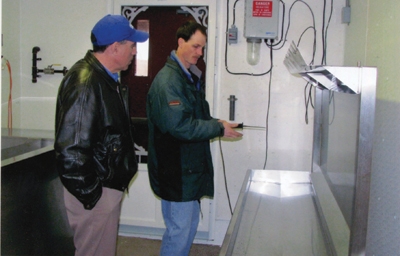
Filling a Gap
By Dan Woolley
Features Processing Production Poultry ProductionThe Taylors have built a provincially licensed poultry plant to fill a shortage in processing capacity in south-central Nova Scotia
 Filling a gap. Cameron Taylor demonstrates an electric knife at his new abattoir’s kill table to invited open house guest David Morse.
Filling a gap. Cameron Taylor demonstrates an electric knife at his new abattoir’s kill table to invited open house guest David Morse. A Nova Scotia farm family has moved its poultry operation farther up the value-added production chain.
Beth Taylor and her son Cameron have been custom-killing poultry for small backyard flock owners for several years now at their farm in Centre Burlington, Hants County.
This year they built a 2,080-square-foot plant, Nova Scotia’s ninth provincially licensed poultry processing abattoir, Cogmagun Poultry Processing Co. Ltd.
Cameron said they wanted to open up for licensed producers. “There is a shortage of processing capacity in the fall when the heavy slaughter period comes. That is the main reason we expanded to a provincially inspected plant.”
They intend to process 500 birds a day, two to three days a week, he said.
The Taylors now slaughter chickens, turkeys and waterfowl from a wide area of south-central Nova Scotia that stretches from Lunenburg to the Annapolis Valley, the Halifax Regional Municipality and the Musquodoboit Valley.
Cameron remarked flock owners come a considerable distance to have them slaughter their birds. “So there must be a need for this plant.”
The Taylors run the abattoir with the help of Cameron’s father-in-law, Gilford Shrum. But when they increase production, they will look at adding more employees.
William Feltmate, the Nova Scotia Department of Agriculture’s (NSDA) senior meat inspector said the abattoir will expand the access to provincially inspected processing plants and open up new markets for small poultry producers.
Feltmate said the Cogmagun abattoir’s processed and inspected poultry could go to retail sales in farmers or roadside markets, or for the flock owner’s home consumption.
Free-range poultry must be slaughtered in a provincially inspected plant, he stated, and any poultry products sold at roadside or farmers markets must be inspected.
The Taylors’ processing equipment, their kill table, feather soaker, plucker, evisceration table and two chilling tanks (converted bulk milk coolers) are all stainless steel.
After eviscerating and chilling the carcasses, they store them in a chill room prior to shipment for sale.
Before building their new abattoir, they got advice from Feltmate, said Cameron. “A few years ago we talked to him about what we wanted to do. He has been with us since we started this project.”
Nova Scotia agriculture minister John MacDonell, speaking at the Taylors’ abattoir’s open house and grand opening, said Nova Scotia Department of Agriculture personnel are really committed to rural Nova Scotia. “I am glad we were able to help. I remember the day he [Cameron] came to my office. We had a long discussion.”
Beth Taylor noted the financial help they received from the NSDA’s programs for strategic infrastructure and food safety infrastructure development.
MacDonell considered their abattoir “a key component of on-farm diversification. This is something we want to see in Nova Scotia. We are not a monoculture like the west.”
Print this page